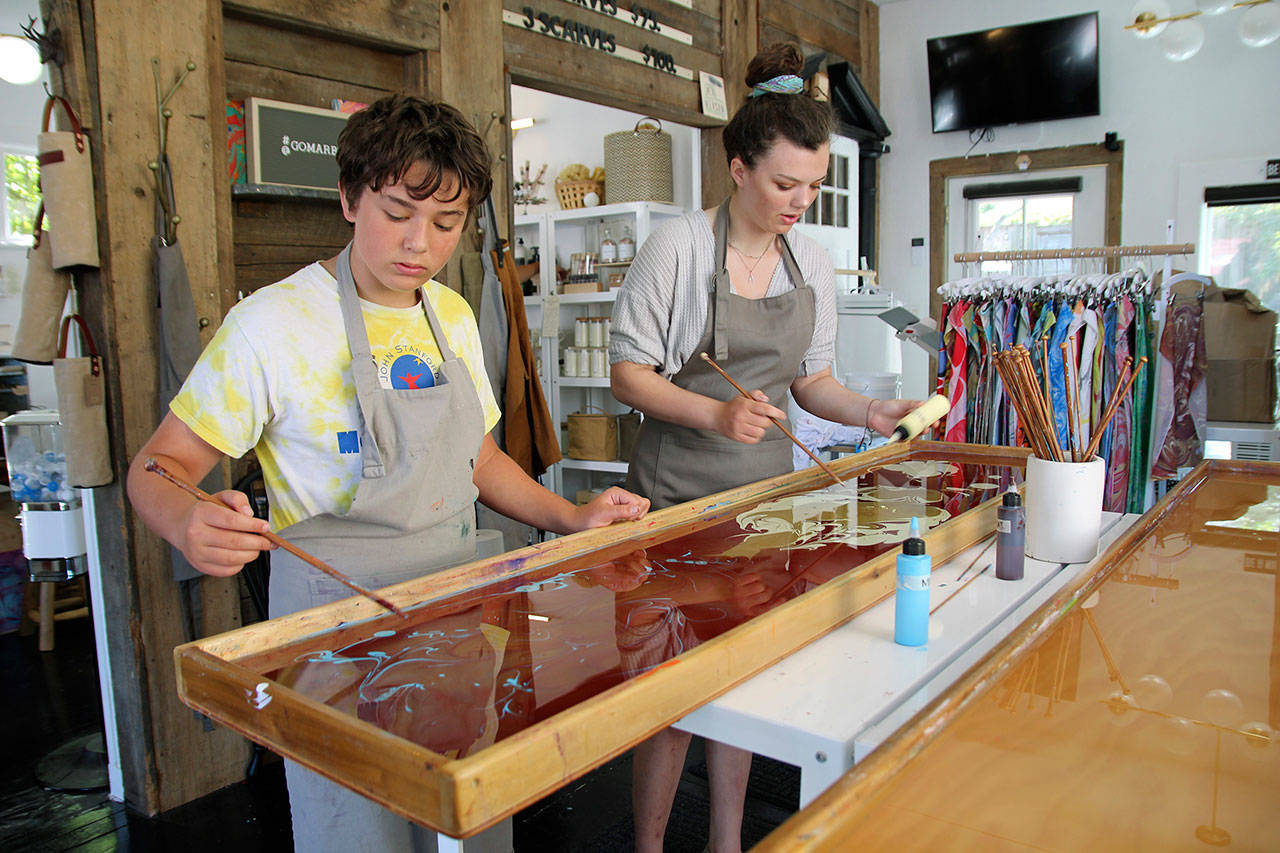A drop of blue spreads rapidly across the still water, growing and filling space until it remains motionless, unable to stretch any further. More of the baby blue paint follows.
A rapt audience watches as the next dashes of acrylic color — red, beige, grey, yellow — bleed across the surface of the now color-filled water tray, punctuating the suspended blue paint with a contrast of blobby circles and oval dots.
Last Thursday, Ed Hodson and Joan Samson demonstrated to a small crowd the step-by-step process for water marbling, at their studio and store, Marbley. The married couple and self-described “serial-entrepreneurs” opened their doors earlier this month at 7 NW Front St., Coupeville.
At Marbley’s “paint-your-own”-style studio, adventurous visitors can design their own silk scarf for $39 and about 25 minutes, a relatively simple process that leaves lots of room for personal taste.
The technique of floating paint on water, or water marbling, may be something new for Front Street, but it’s an ancient form of art with many different styles.
“The art itself is about a thousand years old,” Samson said.
Suminagashi, a Japanese word for ink-based marbling, is said to have been developed in the 12th century. Various other terms and styles for the “art of water” have cropped up throughout history and across cultures.
“There’s this 13th century quote, ‘sell your cleverness and buy bewilderment,” Hodson said. “There’s a lot in culture now that makes us try to be clever or try to think of the next cool thing to say or do.”
With the juggle of scheduling doctors appointments, running errands, dealing with auto mechanics or bosses, “there’s this pressure,” he said.
“And this takes away from that. This is more meditative,” he said of water marbling.
First, surface tension is built by adding a gel-starch mix, providing a top layer for paint settle on. Marbling-adventurers can grab bottles of paint from the shelf, squeeze away, and if they wish, use tools provided by the studio to create specific designs.
Not unlike the techniques used by baristas for “latte art,” a stick can be dragged through the paint to make rippling rosettes. If they wish, customers of Marbley can use a giant rake to comb the water for many consistent, sharp cuts in the flowing paint to create any of the many classic patterns of marbling, from “Nonpareil” to “Flamenco.”
After a satisfactory pattern is built, the 100 percent silk scarf is gently placed on top, transferring the design.
Peeling away the sopping wet scarf from the water, the swirling patterns of the paint come up with it, and the dripping scarf is folded and wrapped “to go” in a small plastic baggie. And then worn, if desired.
“There’s like a 100 ways to fold a scarf,” Samson said. They wear their own creations regularly.
The swirling patterns of marbling can be spotted in everyday life, from stationary to wallpaper to bookbinding or coasters. In this case, Hodson and Samson stumbled upon the water marbling at an arts and crafts festival in Southern California, where they are originally from.
“We basically fell in love with the art form,” Hodson said. “… it’s such a delight to do it. And I wanted people to have the chance to experience that in their lives as well.”
Between the two of them, they’ve worked in the restaurant business, hospitality, precious metals, sales, chocolate and more. They sold their cafe and moved to Whidbey after a search for a small, waterside town with a strong sense of community to raise their 4-year-old son, Hale, who is also now an enthusiastic-marbler.
“Kids love (marbling),” Hodson said. Seeing grown-ups let loose too, even the ones who don’t think they are artistically inclined, is a source of joy for them, Samson and Hodson say.
“Try and be open to the process and just let the paint unfurl,” is Samson’s advice to those new to marbling.
“It’s super easy to do it. So we have (people) in here all the time and people who say they’re not artistic,” Hodson said.” They make amazing things.”
For siblings Cate and Jack Culligan, they were pleased with the results of their scarf-marbling experience, a surprise present for their mother.
“It was fun,” 13-year-old Jack said. He doesn’t consider himself to be artistically inclined, like his sister, but “my design came out well,” he said.
“The trickiest part is figuring out when to stop,” Hodson said of layering the paint. But no need to limit the amount of marbled art, which can be done on any object, from wood signs to paper.
At the rustic-style studio and waterfront shop, there are many examples of the couple’s work, available for purchase.
They now make a scarf every day.


